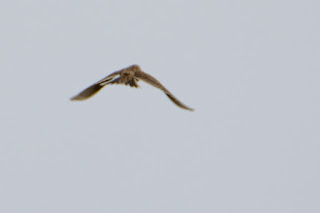 |
| Greenfinch |
It was just before1300 when I headed out. A Blackbird sang loudly from a nearby roof, a Herring Gull wandered around on the road. Feral Pigeons and Swifts flew around, the Swifts much higher in the sky than the pigeons. A Lesser Black Backed Gull was perched on the chimney stack of a nearby tenement and a Woodpigeon landed in a bush near the bus stop. Carrion Crow was added in the City Centre and a short detour through the Howff graveyard added Goldfinch, Robin and Chaffinch to the list. Starling was added from the bus as it headed out along Perth Road.
When I arrived at the park there seemed to be little happening initially. My attention was caught by an interesting plane in the circuit at Dundee Airport - a Vietnam War era ex-US Army Cessna O-1 Bird-Dog which is based at the airport these days. This ended up being photographed far more often than the birds. There were a few birds near the eastern entrance though - A Carrion Crow on the grass in the field, a Song Thrush which flew into the small wooded area and a small flock of Starlings chattering noisily as they picked around on the ground. A Swallow perched on the overhead wires which run along the roadside edge of the park.
A Woodpigeon flew off from Buzzard Wood as I wandered along the path. A pair of Mallards waddled off into the boggy area in front of the wood. There was a bit of sudden noise and then the reason hove into view, a hunting Sparrowhawk which weaved through the tops of the trees before venturing up and over the top and out of sight. At the car park I found Long Tailed Tits in the bushes, their distinctive calls making them easy to pick out, though their diminutive size can make them hard to find among the branches. An Oystercatcher, calling loudly, flapped its way over. Up ahead a male Blackbird hopped around on the grass.
A male Yellowhammer sang from within the compost area. To the north, and Ninewells, I could see a Buzzard being harassed by a Carrion Crow. The tide was well out when I reached the bay, so I wasn't expecting to see much variety. Shelducks were dotted around, mostly distantly. A Whitethroat sang from various perches nearby. Black Headed, Herring and Lesser Black Backed Gulls could be seen well out on the mud as well as a number of Mallards but waders were in very short supply. Heading further along to the hide I watched a House Martin hunting for insects. A pair of Mute Swans were with the gulls in front of the hide along with Feral Pigeons. A House Sparrow in the bushes here was a surprise.
I headed back to the hill to watch for Skylarks, of which I managed a single bird. There were however, plenty of dog owners completely ignoring the signs asking for dogs to be kept on leads with dogs, and even some owners wandering across the grassy areas on the hill where we were hoping the Skylarks would be able to breed relatively undisturbed with the measures introduced by Dundee City Council being put in place. Sadly, it seems the 'nation of animal lovers' spiel we hear trumpeted by the media, only extends as far as dogs and cats for a large chunk of the British public, and indeed nature seems to be an inconvenience to them, rather than the vital factor in the balance of life on the planet that it actually is.
Depressingly, by the time I left the park, I had counted 20 dogs off leads and only 2 on - 1 was a puppy and the owner had 2 other dogs wandering around off the paths, 1 of which would not come back to her no matter how often she shouted for it to. The other was initially off the lead but I spoke to the owner and didn't really get a positive response, however I later bumped into them again and the dog was now on a lead and a positive and civilised discussion about the problems inherent in trying to get dog owners to follow the rules, (and those laws about cleaning up after their pets), and the reasons for them, followed. Bigger signs were required was the main suggestion.
Also seen from the hill, was a single Magpie beyond the compost area. A number of Jackdaws were added later in the field by the Highland Cattle. As I headed for the exit after what had been a largely frustrating couple of hours, with very few bird photos taken (plenty of aircraft), I also added a flyover Pied Wagtail near the car park, and a singing Reed Bunting in the bushes by the boggy area. A quartet of Greenfinches in Buzzard Wood and a male Chaffinch in the bushes near the gate at the eastern end rounded off the list for the day.
 |
| Yellowhammer |
 |
| Buzzard |
 |
| Carrion Crow |
 |
| Carrion Crow |
 |
| Skylark |
 |
| Cessna O-1 Bird-Dog |
 |
| Greenfinch |
11 species seen outwith the park - Blackbird, Carrion Crow, Chaffinch, Goldfinch, Herring Gull, Lesser Black Backed Gull, Robin, Feral Pigeon, Starling, Swift, Woodpigeon.
28 species seen at the park - Blackbird, Black Headed Gull, Buzzard, Carrion Crow, Chaffinch, Greenfinch, Herring Gull, House Martin, House Sparrow, Jackdaw, Lesser Black Backed Gull, Long Tailed Tit, Magpie, Mallard, Mute Swan, Oystercatcher, Pied Wagtail, Reed Bunting, Feral Pigeon, Shelduck, Skylark, Song Thrush, Sparrowhawk, Starling, Swallow, Whitethroat, Woodpigeon, Yellowhammer.
31 species in total.

















































